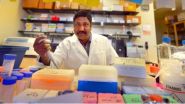(Press-News.org) When Gulf of Mexico algae don't get enough nutrients, they focus their remaining energy on becoming more and more poisonous to ensure their survival, according to a new study by scientists from North Carolina State University and the National Oceanic and Atmospheric Administration.
The study shows that harmful and ubiquitous Karenia brevis algae, which cause red tide blooms across the Gulf of Mexico, become two to seven times more toxic when levels of phosphorus, a major algal nutrient found in fertilizers and human waste, are low. Like wearing a suit of armor, producing highly toxic cells allows the algae to defend themselves against opportunistic waterborne grazers like zooplankton.
Red tide blooms in the Gulf are linked to fish kills and other ecological and economic damage in the region, and are also linked to respiratory ailments in humans. These blooms occur annually in the Gulf, but it's hard to predict where or when they'll occur or how long they'll last.
Drs. Rance Hardison and Damian Shea, co-authors on a paper appearing online in the journal PLOS ONE, say that the findings could help coastal managers make better predictions about the harmful effects of red tide blooms.
"Public-health managers can test phosphorous levels in waters across various Gulf locations," Hardison said, "and know that low levels could indicate highly toxic red tide blooms. Then they can close nearby shellfish beds or take other measures to keep sea life – and humans – safe."
The researchers tested five different K. brevis species from varied geographic locations and limited some samples' growth by withholding phosphorus while allowing others to enjoy a full diet of phosphorus. Depending on the species, algal cells with limited access to phosphorus had 2.3 to 7.3 times more toxin than algal cells that were filled up with phosphorous.
"At the end of a red tide bloom, when the nutrients are used up, K. brevis cells produce a burst of toxicity. Now we understand the biological mechanism behind some of the varied toxic levels seen in Gulf algal cells," Shea, an NC State professor of biology and environmental toxicology, said.
The irony of the inverse relationship between phosphorous and algal toxicity is not lost on the researchers. In a modern-day catch-22, excess nutrients like phosphorus and nitrogen play key roles in fueling algal growth and harmful algal bloom development. As bloom density increases, cells use up the available nutrients such as phosphorous. This slows the growth of K. brevis cells causing them to become more toxic. Previous research conducted by Hardison, a NOAA oceanographer who received his Ph.D. from NC State, showed similar effects when nitrogen was the limiting nutrient.
"We believe the findings will be useful to help model future toxic algal blooms and how harmful they'll be," Hardison said.
INFORMATION:
Note to editors: An abstract of the paper follows.
Increased toxicity of Karenia brevis during phosphate limited growth: ecological and evolutionary implications
Authors: D. Ransom Hardison, William Sunda, R. Wayne Litaker, National Oceanic and Atmospheric Administration; Damian Shea, North Carolina State University
Published: March 12, 2013, online in PLOS ONE
Abstract: Karenia brevis is the dominant toxic red tide algal species in the Gulf of Mexico. It produces potent neurotoxins (brevetoxins [PbTxs]), which negatively impact human and animal health, local economies, and ecosystem function. Field measurements have shown that cellular brevetoxin contents vary from 1? 68 pg/cell but the source of this variability is uncertain. Increases in cellular toxicity caused by nutrient-limitation and inter-strain differences have been observed in many algal species. This study examined the effect of P-limitation of growth rate on cellular toxin concentrations in five Karenia brevis strains from different geographic locations.
Phosphorous was selected because of evidence for regional P-limitation of algal growth in the Gulf of Mexico. Depending on the isolate, P-limited cells had 2.3- to 7.3-fold higher PbTx per cell than P-replete cells. The percent of cellular carbon associated with brevetoxins (%C-PbTx) was ~ 0.7 to 2.1% in P-replete cells, but increased to 1.6? 5% under P-limitation. Because PbTxs are potent anti-grazing compounds, this increased investment in PbTxs should enhance cellular survival during periods of nutrient-limited growth. The %C-PbTx was inversely related to the specific growth rate in both the nutrient-replete and P-limited cultures of all strains. This inverse relationship is consistent with an evolutionary tradeoff between carbon investment in PbTxs and other grazing defenses, and C investment in growth and reproduction. In aquatic environments where nutrient supply and grazing pressure often vary on different temporal and spatial scales, this tradeoff would be selectively advantageous as it would result in increased net population growth rates. The variation in PbTx/cell values observed in this study can account for the range of values observed in the field, including the highest values, which are not observed under N-limitation. These results suggest P-limitation is an important factor regulating cellular toxicity and adverse impacts during at least some K. brevis blooms.
When hungry, Gulf of Mexico algae go toxic
Limited phosphorus makes Karenia brevis algae even meaner
2013-03-13
ELSE PRESS RELEASES FROM THIS DATE:
Marine diversity study proves value of citizen science
2013-03-13
Citizen science surveys compare well with traditional scientific methods when it comes to monitoring species biodiversity – according to new research from the University of East Anglia.
Research published today in the journal Methods in Ecology and Evolution shows that methods to record marine diversity used by amateurs returned results consistent with techniques favoured by peer-reviewed science.
The findings give weight to the growing phenomenon of citizen science, which sees data crowd-sourced from an army of avid twitchers, divers, walkers and other wildlife enthusiasts. ...
'I don't want to pick!' Preschoolers know when they aren't sure
2013-03-13
Children as young as 3 years old know when they are not sure about a decision, and can use that uncertainty to guide decision making, according to new research from the Center for Mind and Brain at the University of California, Davis.
"There is behavioral evidence that they can do this, but the literature has assumed that until late preschool, children cannot introspect and make a decision based on that introspection," said Simona Ghetti, professor of psychology at UC Davis and co-author of the study with graduate student Kristen Lyons, now an assistant professor at Metropolitan ...
Promising new drug treats and protects against radiotherapy-associated oral mucositis
2013-03-13
Mouse model studies show that administered genetically or topically, protein Smad7 protects against or heals mouth sores commonly associated with cancer treatment.
In some cancer patients treated with radiation, the mouth sores known as oral mucositis become so severe that feeding tubes are required for nutrition and narcotics are needed for pain. In fact, 40-70 percent of patients treated with upper-body radiation develop the condition to some degree. Currently, there is no FDA approved treatment. A University of Colorado Cancer Center study published this week in the ...
Political strife undermines HIV treatment
2013-03-13
PROVIDENCE, R.I. [Brown University] — As Kenyan citizens negotiated the tensions following the March 4 nationwide elections, memories of the violence that followed the December 2007 vote weighed heavily for many reasons. Among those in any nation with an HIV epidemic, argue authors of a new paper in AIDS Reviews, should be the long-term damage that political conflict can do to public health by disrupting treatment and thereby promoting resistance to antiretroviral drugs and treatment failure.
"It's the long-term consequences that make this a bigger issue," said lead author ...
Potential early indicator of kidney injury identified
2013-03-13
AUGUSTA, Ga. – A guidance cue that helps kidneys form may also be a red flag that they are in danger, researchers report.
Acute kidney injury, a common and serious complication of hospitalization, is on the increase worldwide, affecting an estimated 6 percent of all hospitalized patients and 30-40 percent of adults and children having cardiopulmonary bypass surgery.
About 10-15 percent of acute injuries translate to chronic kidney damage or failure that may require dialysis or a kidney transplant, said Dr. Ganesan Ramesh, kidney pathologist in the Vascular Biology ...
A European invader outcompetes Canadian plants even outside its usual temperature range
2013-03-13
Dog-strangling vine (Vincetoxicum rossicum) is an exotic plant originating from the Ukraine and southeastern Russia that is becoming increasingly invasive in southern Ontario, Canada. It has been found growing successfully in both disturbed and undisturbed areas, in open fields, forest edges and understories, parks, road edges and railway embankments. The invasive plant effectively competes for light by forming large and dense stands that climb over other plants. A study published in the open access, peer-reviewed journal NeoBiota explores the effects of V. rossicum invasion ...
The natural ecosystems in the Colombian Orinoco Basin are in danger
2013-03-13
The Orinoco River flows from the Andes in Colombia to the Atlantic in Venezuela. The area of the basin includes landscapes of the Andes, plains of the Llanos and the Guiana shield. Orinoco's tributary rivers form a basin considered to be the 3rd most important river system on the planet, and one of the most biologically diverse areas of the world.
Colombia has shown a strong commitment to the achievement of the Convention on Biological Diversity's 2010 biodiversity target, by promoting the conservation of at least 10% of its natural ecosystems. Protected Area categories ...
Astronomers observe planets around another star like never before
2013-03-13
PASADENA, Calif.—Thanks to a new high-tech gadget, astronomers have observed four planets orbiting a star relatively close to the sun in unprecedented detail, revealing the roughly ten-Jupiter-mass planets to be among the most exotic ones known.
The team, which includes several researchers from the California Institute of Technology (Caltech), describes its findings in a paper accepted for publication by the Astrophysical Journal.
The findings were made possible by a first-of-its-kind telescope imaging system that allowed the astronomers to pick out the planets amidst ...
Cancer researchers discover new type of retinoblastoma in babies
2013-03-13
(TORONTO, Canada – March 13, 2013) – A team of Canadian and international cancer researchers led by Dr. Brenda Gallie at the Princess Margaret Cancer Centre, University Health Network (UHN), has discovered a new type of retinoblastoma, a rapidly developing eye cancer that affects very young babies– a finding that can immediately change clinical practice and optimize care for these children.
The finding, published online today in Lancet Oncology, is a breakthrough in recognizing that a single cancer gene (an oncogene) drives an aggressive retinoblastoma that starts long ...
Canadians support interventions to reduce dietary salt
2013-03-13
Philadelphia, PA, March 13, 2013 – Many Canadians are concerned about dietary sodium and welcome government intervention to reduce sodium intake through a variety of measures, including lowering sodium in food, and education and awareness, according to a national survey. The top barriers to limiting sodium intake are a lack of lower sodium packaged and processed foods and lower sodium restaurant menu options.
"Canadians are supportive of government intervention to lower salt intake," says lead investigator Mary R. L'Abbe, PhD, Professor and Chair of the Department of ...
LAST 30 PRESS RELEASES:
Numbers in our sights affect how we perceive space
SIMJ announces global collaborative book project in commemoration of its 75th anniversary
Air pollution exposure and birth weight
Obstructive sleep apnea risk and mental health conditions among older adults
How talking slows eye movements behind the wheel
The Ceramic Society of Japan’s Oxoate Ceramics Research Association launches new international book project
Heart-brain connection: international study reveals the role of the vagus nerve in keeping the heart young
Researchers identify Rb1 as a predictive biomarker for a new therapeutic strategy in some breast cancers
Survey reveals ethical gaps slowing AI adoption in pediatric surgery
Stimulant ADHD medications work differently than thought
AI overestimates how smart people are, according to HSE economists
HSE researchers create genome-wide map of quadruplexes
Scientists boost cell "powerhouses" to burn more calories
Automatic label checking: The missing step in making reliable medical AI
Low daily alcohol intake linked to 50% heightened mouth cancer risk in India
American Meteorological Society announces Rick Spinrad as 2026 President-Elect
Biomass-based carbon capture spotlighted in newly released global climate webinar recording
Illuminating invisible nano pollutants: advanced bioimaging tracks the full journey of emerging nanoscale contaminants in living systems
How does age affect recovery from spinal cord injury?
Novel AI tool offers prognosis for patients with head and neck cancer
Fathers’ microplastic exposure tied to their children’s metabolic problems
Research validates laboratory model for studying high-grade serous ovarian cancer
SIR 2026 delivers transformative breakthroughs in minimally invasive medicine to improve patient care
Stem Cell Reports most downloaded papers of 2025 highlight the breadth and impact of stem cell research
Oxford-led study estimates NHS spends around 3% of its primary and secondary care budget on the health impacts of heat and cold in England
A researcher’s long quest leads to a smart composite breakthrough
Urban wild bees act as “microbial sensors” of city health.
New study finds where you live affects recovery after a hip fracture
Forecasting the impact of fully automated vehicle adoption on US road traffic injuries
Alcohol-related hospitalizations from 2016 to 2022
[Press-News.org] When hungry, Gulf of Mexico algae go toxicLimited phosphorus makes Karenia brevis algae even meaner





